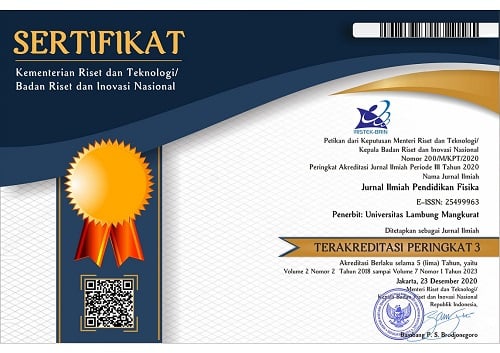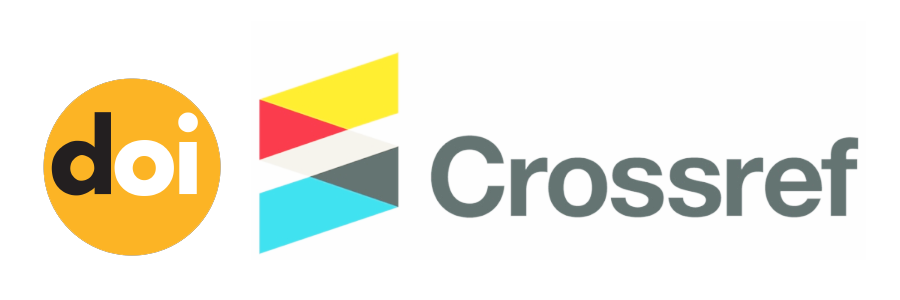Pengembangan Instrumen Tes Keterampilan Problem Solving pada Materi Gerak Lurus di SMA
Abstract
Penelitian ini bertujuan untuk menghasilkan instrument tes keterampilan problem solving yang valid dan mengetahui kelayakan instrumen tes keterampilan problem solving pada materi gerak lurus. Penelitian ini menggunkan model (Research andDevelopment). Dalam penelitian ini menggunakan model 4D denganlangkah-langkahDefine,Design,Develop dan Dissemination. Namun untuk penelitian ini dibatasi sampai tahap 3D yaitu Define,Design, dan Develop. Tahapan analisis pada Define dilakukan dengan penyebaran angket kebutuhan yang dilakukan di tiga sekolah yaitu SMA N 7 Kota Bengkulu, SMA N 4 Kota Bengkulu, dan SMA N 9 Kota Bengkulu kemudian dilakukan perancangan pengembangan instrument soal. Instrumen tes berisikan 6 soal uraian yang menggunakan indikator keterampilan problem solving. Setelah itu instrument yang telah disusun divalidasi oleh tiga pakar yaitu dua ahli dan satu praktisi. Berdasarkanhasilujivalidasiaspekmateri, aspek konstruksi, aspek bahasa memperoleh persentase validasi berturut-turut sebesar 100%, 98,6% dan 100%. Dengan demikian instrumen yang disusun dikategorikansangat layak digunakan.
This study aims to produce a valid problem-solving skill test instrument and determine the feasibility of a problem-solving skill test instrument on straight-motion material.This research uses a model (Research and Development). The development model used is a 4D model with the steps of Define, Design, Develop and Dissemination. However, this research is limited to the 3D stage, namely Define, Design, and Develop. The analysis stage in Define was carried out by distributing a needs questionnaire which was carried out in three schools, namely SMA N 7 Bengkulu City, SMA N 4 Bengkulu City, and SMA N 9 Bengkulu City; then carried out the design of the question instrument development. The test instrument contains six description questions that use problem-solving. After that, the instrument that has been compiled is validated by three experts, namely two experts and one practitioner. Based on the validation test results, the material aspect, construction aspect, and language aspect obtained validation percentages of 100%, 98.6% and 100%, respectively. Thus, the instruments compiled are categorized as very suitable for use.
Keywords
Full Text:
PDFReferences
Aristiawan, A. (2022). Profil kemampuan masalah fisika siswa sma menggunakan soal essay. Jurnal Tadris IPA Indonesia, 2(1), 44–55.
Asysyifa, D. S., . J., Wilujeng, I., & Kuswanto, H. (2019). Analysis of students critical thinking skills using partial credit models (pcm) in physics learning. International Journal of Educational Research Review, 245–253.
Binkley, M., Erstad, O., Herman, J., Raizen, S., Ripley, M., Miller-Ricci, M., & Rumble, M. (2014). Defining twenty-first century skills. In Assessment and teaching of 21st century skills.
Căprioară, D. (2015). Problem solving - purpose and means of learning mathematics in school. Procedia-Social and Behavioral Sciences, 191, 1859–1864.
Chang, H. C., Wang, N. Y., Ko, W. R., Yu, Y. T., Lin, L. Y., & Tsai, H. F. (2017). The effectiveness of clinical problem-based learning model of medico-jurisprudence education on general law knowledge for Obstetrics/Gynecological interns. Taiwanese Journal of Obstetrics and
Gynecology, 56(3), 325–330.
https://doi.org/10.1016/j.tjog.2017.04.011
Docktor, J. L. & K. H. (2009). in This Context Refers To the Agreement of Scores From Multiple. Proceedings of the NArST 2009.
Gumilang, N. S. R., Wahidin, W., & Tsurayya, A. (2021). Pengembangan instrumen kemampuan berpikir kritis dan kreatif matematika peserta didik kelas vii smp. Jurnal Pendidikan Matematika dan Sains, 9(2), 89-98.
Haridza, R., & Irving, K. E. (2017). Developing critical thinking of middle school students using problem based learning 4 core areas (pbl4c) model. Journal of Physics: Conf. Series 812.
Heller, K., & Heller, P. (2010). Cooperative problem solving in physics a user’s manual. University of Minnesota, 310.
Hidayat, S. R., Setyadin, A. H., Hermawan, H., Kaniawati, I., Suhendi, E., Siahaan, P., & Samsudin, A. (2017). Pengembangan instrumen tes keterampilan pemecahan masalah pada materi getaran, gelombang, dan bunyi. Jurnal Penelitian & Pengembangan Pendidikan Fisika, 3(2), 157–166. https://doi.org/10.21009/1.03206
Huitt, W. G. (1992). Problem Solving and decision making: Consideration of Individual Differences Using the Myers-Briggs Type Indicator. Journal of Psychology Type, 24, 33–44.
Husamah, H. (2015). Blended project based learning: Metacognitive awareness of biology education new students. Journal of Education and Learning (EduLearn), 9(4), 274–281.
Ince, E. (2018). An overview of problem solving studies in physics education. Journal of Education and Learning, 7(4), 191. https://doi.org/10.5539/jel.v7n4p191
Kane, S. N., Mishra, A., & Dutta, A. K. (2017). Developing critical thinking of middle school students using problem based learning 4 core areas (PBL4C) Model. Journal of Physics: Conference Series, 755(1). https://doi.org/10.1088/1742-6596/812/1/012081
Khoiriyah, A. J., & Husamah, H. (2018). Problem-based learning: Creative thinking skills, problem-solving skills, and learning outcome of seventh grade students. JPBI (Jurnal Pendidikan Biologi Indonesia), 4(2), 151–160.
Kurniawan, D., Dewi, S. V., & Kerja, L. (2017). Pengembangan perangkat pembelajaran dengan media screencast- o-matic mata kuliah kalkulus 2 menggunakan model 4-D Issn 2476-9312. 3(1), 16-25.
Lestari, K., Maria S, H. T., & Mahmuda, D. (2019). Penerapan penyelesaian masalah heller untuk meningkatkan kemampuan menyelesaikan soal materi gera lurus. Jurnal Pendidikan Dan Pembelajaran Khatulistiwa, 8(3), 2–9.
Lestari, P. E., Purwanto, A., & Sakti, I. (2019). Pengembangan instrumen tes keterampilan pemecahan masalah pada konsep usaha dan energi di sma. Jurnal Kumparan Fisika, 2(3), 161–168.
Lucenario, J. L. S., Yangco, R. T., Punzalan, A. E., & Espinosa, A. A. (2016). Pedagogical content knowledge-guided lesson study: effects on teacher competence and students’ achievement in chemistry. Education Research International, 2016, 1–9.
Muntazhimah, M., Putri, S., & Khusna, H. (2020). Rasch model untuk memvalidasi instrumen resiliensi matematis mahasiswa calon guru matematika. JKPM (Jurnal Kajian Pendidikan Matematika), 6(1), 65-75.
Nadapdap, A., & Istiyono, E. (2017). Developing physics problem-solving skill test for grade X students of senior high school. REiD (Research and Evaluation in Education), 3(2), 114–123.
Nuzliah, N. (2016). Kontribusi motivasi belajar, kreativitas terhadap problem solving (pemecahan masalah) siswa dalam belajar serta implikasi terhadap bimbingan dan konseling di smpn 29 padang. JURNAL EDUKASI: Jurnal Bimbingan Konseling, 1(2), 157.
Putri, D. H., Risdianto, E., & Sutarno, S. (2017). Identifikasi keterlaksanaan praktikum fisika sma dan pembekalan keterampilan abad 21. Program Studi Pendidikan Biologi Fakultas Pendidikan Matematika, IImu Pengetahuan Alam Dan Teknologi Informasi
Universitas PGRI Semarang, 114.
Reddy, M. V. B., & Panacharoensawad, B. (2017). Students problem-solving difficulties and implications in physics: an empirical study on influencing factors. Journal of Education and Practice, 8(14), 59–62.
Ridho, M. H., Wati, M., Misbah, M., & Mahtari, S. (2020). Validitas bahan ajar gerak melingkar berbasis authentic learning di lingkungan lahan basah untuk melatih keterampilan pemecahan masalah. Journal of Teaching and Learning Physics, 5(2), 87-98.
Risma, R., Nur, F., Siahaan, P., & Samsudin, A. (2015). Deskripsi instrumen tes keterampilan berpikir kritis materi alat optik. Simposium Nasional Dan Pembelajaran Sains 2015 (SNIPS 2015), 2015(Snips), 497–500.
Rizki, M., Wati, M., & Misbah, M. (2021). Electronic thermodynamics teaching materials based on authentic learning to practice students’ problem-solving skills: Aspects of validity. Journal of Physics: Conference Series, 2104(1), 012018.
Saputri, S. R., Wati, M., & Misbah, M. (2021). Simple harmonic motion electronic teaching materials based on authentic learning to train students’ problem-solving skills: aspects of validity. Journal of Physics: Conference Series, 2126(1), 012016.
Schettino, C. (2016). The interdisciplinary journal of problem-based learning article a framework for problem-based learning : teaching mathematics with a relational problem-based pedagogy. Interdisciplinary Journal of Problem-Based Learning, 10(2).
Sudarmo, M. N. P., & Mariyati, L. I. (2018). Kemampuan problem solving dengan kesiapan masuk sekolah dasar. Psikologia : Jurnal Psikologi, 2(1), 38.
Surya, E., & Putri, F. A. (2017). Improving mathematical problem-solving ability and self-confidence of high school students through contextual learning model. Journal on Mathematics Education, 8(1), 85-94.
Thersia, V., Arifuddin, M., & Misbah, M. (2019). Meningkatkan kemampuan pemecahan masalah melalui pendekatan somatis auditori visual intelektual (savi) dengan model pengajaran langsung. Berkala Ilmiah Pendidikan Fisika, 7(1), 19.
Wati, M., Sutiniasih, N., Misbah, M., Mahtari, S., Annur, S., & Mastuang, M. (2020). Developing of physics teaching materials based on authentic learning to train problem-solving skills. Journal of Physics: Conference Series, 1567 (3), 032084.
Winarso, W. (2014). Problem solving, creativity dan decision making dalam pembelajaran matematika. Eduma : Mathematics Education Learning and Teaching, 3(1).
Yulia, I., Connie, C., & Risdianto, E. (2018). Pengembangan lkpd berbasis inquiry berbantuan simulasi phet untuk meningkatkan penguasaan konsep gelombang cahaya di kelas xi mipa sman 2 kota bengkulu. Jurnal Kumparan Fisika, 1(3), 64–70.
Yulianto, A., & Widodo, A. (2020). Disclosure of difficulty distribution of hots-based test questions through rasch modeling. Indonesian Journal of Primary Education, 4(2), 197–203.
DOI: https://doi.org/10.20527/jipf.v6i3.6809
Refbacks
- There are currently no refbacks.
Indexed by: Jurnal Ilmiah Pendidikan Fisika is licensed under a creative commons attribution-share alike 4.0 international license
Statistics Counter |
















